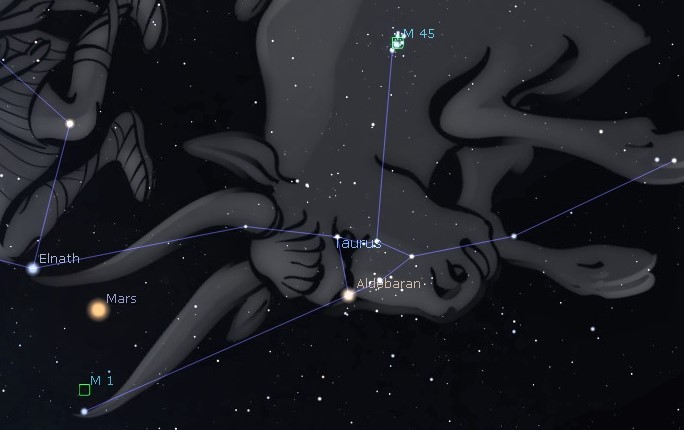This Week’s Sky at a Glance, 2022 November 26 – December 3 ~by Curt Nason
The constellation of Taurus the Bull has completely cleared the eastern horizon by 6:30 pm this week. It is distinguished by two relatively close star clusters: the compact dipper-shaped Pleiades (M45) in the bull’s shoulder and the V-shaped Hyades that forms the bull’s face. The bright orange star Aldebaran anchors one side of the V, representing the bull’s fiery eye, but it is not actually part of the cluster as it is much closer. In mythology the Pleiades (aka the Seven Sisters) and the Hyades were half-sisters; daughters of Atlas, who obviously didn’t spend all his time holding up the sky.
Starting from the apex of the Hyades, extend each side of the V outward to a star. These stars are the tips of the bull’s horns. The upper star is Elnath, which forms one of the corners of Auriga the Charioteer although it is officially part of Taurus. The other horn star has a famous dim neighbour, which is about one degree away and slightly to the right of a line joining the horns. Called the Crab Nebula or M1 for being the first entry in Charles Messier’s 18th century catalogue, this little fuzzy patch is a gaseous supernova remnant. The supernova, a death-explosion of a giant star, was seen in daylight for three weeks in 1054. I have seen M1 in a transparent sky with binoculars but a scope gives a better view. Mars will spend the week moving westward between the horns.
This Week in the Solar System
Saturday’s sunrise in Moncton is at 7:37 am and sunset will occur at 4:45 pm, giving 9 hours, 8 minutes of daylight. Next Saturday the Sun will rise at 7:45 am and set at 4:42 pm, giving 8 hours, 57 minutes of daylight.
The Moon is at first quarter on Wednesday, when telescope users can see the Lunar X just within the shadow around 5 pm. The Moon passes near Saturn on Monday and Jupiter on Thursday. Saturn is setting just after 10 pm this week so observe it early. On Sunday evening binocular and telescope users can watch the giant moon Ganymede disappear behind Jupiter at 5:15 and reappear on the other side at 8:10, and then disappear into Jupiter’s shadow at 10:23 for a few hours. Mars is closest to Earth on Wednesday, just over a week from opposition.
Weather permitting there will be public observing at Wolastuk Park near Reversing Falls in Saint John on December 1 from 6 to 7:30 pm, in conjunction with the lighting of a Christmas tree sponsored by JD Irving Ltd.
On Sunday evening at 8 pm, tune in to the Sunday Night Astronomy Show via the Facebook page or YouTube channel of Astronomy by the Bay.
Questions? Contact Curt Nason.

